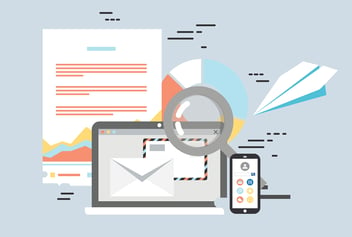In this blog we're going to take a look at how to structure a PPC campaign for success, particularly focusing on B2B campaigns.
This blog is designed as an accompaniment to our PPC training videos, but can also be read as a stand-alone blog.
Watch the PPC training video here:
Using the Triple Ad Group Structure for your PPC Campaigns
You should begin, as you do with any type of campaign, with keyword research. So just a quick reminder, go to the keyword planner in your account, discover new keywords, and for this example, we're going focus on the keyphrase 'HR Software'.
In previous videos, we have gone through how to conduct thorough keyword research. Keeping the same format here, we will look at all the broad keywords and everything that comes with that search. Then we break it down into opportunities using the traffic light system.
Top of the Funnel Keywords
We break keywords down into three different ad group categories, which is what we're going to talk about today. Just a quick reminder, at the top of the funnel we have very broad keywords. Middle-of-the-funnel keywords have slightly higher buyer's intent and the bottom of the funnel has the ultimate buyer's intent, which is where we want to be.
So the main focus of this blog and video is how to structure a campaign and the reasons why we would structure it this way. For the purposes of this example, our campaign would be a generic HR Software campaign. If we use the same tactics as our keyword research, we would structure it top of the funnel at group one, middle of the funnel at group two, bottom of the funnel at group three.
When searching keywords for this example campaign we have very broad keywords like 'HR System' and 'HR System Software'. These have very high-end searches so they're going to come with a lot of search volume and they're going to be highly competitive, both in the paid space and in the organic space. Therefore, that tells us that we're not really going to be bidding aggressively on these words.
Otherwise, you'd spend a lot of money very fast and get little in return for it in terms of revenue. But where these keywords do come into our strategy is that we discover search queries from them. So using the Google Ads phrase, 'match type', we get anything that comes along with HR System. We could have any type of obscure search query come in on this ad group.
Middle of the Funnel Keywords
We discover keywords for our search query report and if they merit it, we then add them to our middle-of-the-funnel ad group. If we see some slightly higher buyer intent in our top-of-the-funnel ad group, we move it into the middle of the funnel where we start to bid a little bit more aggressively. In this ad group, we will then see a higher level of buyer intent.
So the keyword phrase 'HR Software for Small Businesses' will have lower volume and lower CPCs as well because this phrase will be generating more revenue for businesses so people will be bidding more aggressively on it. For us it does merit bidding aggressively if it's bringing in revenue. Also what we'll be looking for here is to provide content. So we would offer certain types of CTAs, white papers, landing pages etc that make people take action on these search queries.
We would also, in the same way as with the previous ad group, be discovering search queries on an ongoing basis that we would be able to add to our bottom-of-the-funnel ad group. We're really just growing out this entire PPC campaign and optimising as we go along.
Bottom of the Funnel Keywords
So at the bottom of the funnel, we would most likely see types of keywords like 'HR Software for Construction Companies'. This is a very specific search query. Therefore, it is an example of someone that is right there in the market, ready to speak to your sales team. So we would bid very competitively on these keywords. They would have a very low volume, but this is where we would see our maximum return inside this structure.
So we not only discover new keywords for each ad group, but we also discover where our revenue's coming from at each stage of the funnel. Therefore, when we optimise and go forward, these keywords might look a lot different. If 'HR System' is just using money and not giving us anything in return, we will have already discovered other top-of-the-funnel keywords in our optimisation.
Then we see what type of revenue is coming from what search queries in the middle of the funnel, so we can control our bids there as well. We bid as aggressively as we're getting a return on investment still. We have our keywords set and we're bidding very aggressively at this point.
Adjusting your Ad Campaign Accordingly
Basically, if it's bringing in revenue we scale it up, if it's not bringing in any revenue we pause. That's what this structure brings us ultimately. So taking the theory of this structure, we would then head back into our account and set up a new campaign as usual. It will be a search campaign and just like always 'HR Software' will be the name of the campaign.
Assuming all of our settings are going to be what we have for our usual campaigns, then we'd add our ad groups, for example, at the top of the funnel. Head back to the research that you've already done, copy that, and now you have your keywords in place. You'll then add your final URLs, your ads and everything else that comes with the campaign.
For the purpose of this video, what we're really focusing on is this triple ad group structure and what it brings, which is maximum control over your bids. It gets rid of traffic that you don't need and ultimately it helps you very quickly identify what is bringing you revenue.
We hope you have enjoyed this blog on 'How to Structure your PPC Campaign for Success'. You can find other PPC Tips blogs on our Marketing Insights page and browse a series of quick handy hints on our PPC Tips page. We are also offering a FREE AUDIT for your pay-per-click campaign.


![Free PPC Audit [Email CTA]](https://no-cache.hubspot.com/cta/default/469237/91082e64-1a12-4e9b-a2b7-d25427f5acb0.png)


